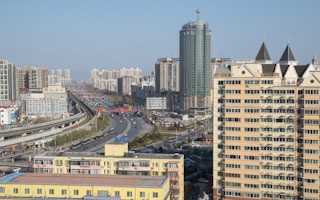The price tag for curbing air pollution and cutting carbon emissions in China’s cities could be as high as 6.6 trillion yuan (US$1 trillion) required in the form of green finance over the next five years, said a new report released in Beijing last week.
The report is an attempt to work out the costs of energy efficient buildings, mass transit systems, infrastructure for electric cars, and clean energy including solar and wind.
It was released during the China-US summit on low carbon cities, part of a bilateral initiative announced last year by mayors and municipalities to meet carbon targets, including at least 20 urban areas in China.
The research focuses on how green loans, bonds, industry funds, carbon finance, and government policies, can spur private investment in the types of infrastructure that are essential for cities to peak and then reduce their carbon footprints.
“
China’s leadership helped make the Paris Climate Agreement possible. Now, China is looking for creative ways to finance the low-carbon infrastructure needed to reach its climate goals.
Michael Bloomberg, special envoy for cities and climate change, UN
Greening China’s urban areas is needed to meet China’s national pollution and carbon reduction targets, including an undertaking to peak energy-related greenhouse gas emissions by 2030 or earlier.
Around 1 billion (or roughly two-thirds) of China’s population are forecast to be living in cities by 2030. In the period spanning 2008 to 2025, around 250 million people are expected to migrate from the countryside to urban areas, one of the biggest movements in human history.
The research on the cost of cutting pollution and carbon in China’s cities was a joint effort by Bloomberg Philanthropies, China’s Green Finance Committee, Paulson Institute, Energy Foundation China and the Chinese Renewable Energy Industries Association to ‘Promote Green Finance for Low-Carbon Cities in China’.
Ma Jun, chief economist at the Research Bureau of People’s Bank of China, said in a statement that green urban development in China cannot happen without support from capital markets.
“Greening of buildings, transportation and energy will be crucial as these sectors are the main sources of urban emissions,” Ma, who chairs the Green Finance Committee, China Society for Banking and Finance, said in a statement to accompany the report.
During the period of the 13th Five-Year Plan (2016-2020), China will need to invest 1.65 trillion yuan to support the construction of greener buildings and large-scale retrofits of existing houses and commercial buildings, the report added.
Meanwhile, low carbon transportation, including 3,000 kilometres of new rail infrastructure and 4.8 million electric cars, will need about 4.45 trillion yuan of financing, the joint report added.
It also said that the installation of 64 gigawatts of solar power would require 500 billion yuan of investment.
China’s Alliance of Peaking Pioneer Cities (APPC), has grown in the past year to include 21 cities and 2 provinces, and has announced peaking targets earlier than the national goal. These cities cover 17 per cent of China’s population, 28 per cent of its GDP and 16 per cent of its GHG emissions.
Efforts at reducing smog, which is caused mostly from the burning of fossil fuels by power stations, industry and vehicles, would also cut greenhouse gas emissions from these same sources and help China reach its targets.
G20
“China’s leadership helped make the Paris Climate Agreement possible. Now, China is looking for creative ways to finance the low-carbon infrastructure needed to reach its climate goals,” said Michael Bloomberg, the UN Secretary General’s Special Envoy for Cities and Climate Change, and a sponsor of the report.
This week, research from Bank of America Merrill Lynch said companies and financial institutions in China were on track to issue around US$46 billion (301 billion yuan) of green bonds this year, “which could be vital to fulfilling the 2-4 trillion yuan of annual environmental investments needed for the country,” it added.
The release of the Bloomberg-sponsored reports and this week’s cities summit in Beijing comes in the run-up to China’s hosting of a G20 meeting in Hangzhou in September.
Among other issues, the G20 meeting will discuss how to funnel the trillions of dollars of finance required for a decisive shift to cleaner energy, and how to deal with the impacts of climate change, particularly in developing countries.
Carbon lock-in
One key element of that finance will be how to avoid locking-in of carbon-intensive infrastructure and city planning that has, for example, made it so difficult for US cities such as Los Angeles and Houston to retrospectively redesign their layouts to reduce reliance on cars.
China’s largest cities are trying to curb the impact of a big increase in car use in recent decades by expanding mass transit systems and deter residents from using cars through levies and licence plate lotteries.
Meanwhile, many Chinese cities have building stock that is deemed to waste energy.
Chinese State Councilor Yang Jiechi told the US-China cities summit that policymakers would need to be ambitious in terms of making cities low carbon, and impart this mindset to citizens.
“When we build up our cities, we have to make sure that the new settlers in the cities will think in the same way as we do in terms of making the city a cleaner place,” he said in a joint statement with US Secretary of State John Kerry.
This story was published with permission from Chinadialogue under a Creative Commons license.








